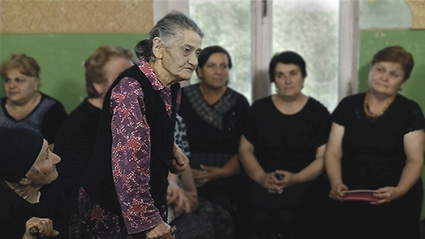The Ruler…a Dead Duck?
The monthly CineClub, in partnership with CineDoc, screened Shalva Shengeli’s documentary ‘The Ruler’ at the Amirani cinema Tuesday, playing as usual to a packed hall of locals and expats.
First, let me explain the headline, because I don’t want you to start out with a negative impression of the documentary itself which, coming from my nine years’ experience living in Georgia, I can say was both entertaining and very well done!
One shot in the movie shows a white duck waddling confidently along the village street while the battle over the Joseph Stalin statue- move it or leave it in the nunnery grounds- rages on. An inspired critic at one of the 21 film festivals ‘The Ruler’ has been filmed at, told Director Shalva Shengeli, “That duck represents the Georgian people- proudly walking on their way to their fate.”
We’re pretty sure he meant to focus on the pride and confidence of walking one’s own way rather than the fact that by the end of the film that duck had been beheaded, plucked and boiled for the opening of the new Stalin garden. We hope.
Tsromi is a small village outside Gori, apparently once known for being a much grander citadel, and boasting a 7th century church. It also boasts a statue of Stalin at the village crossroads, pointing forward, as one villager (jokingly?) told the local priest, “To remind his soldiers to stand ready.”
During the film, we were taken on a tour of the village and its surroundings by one village resident who showed us the chamber in the church in which a young Stalin, on the run from the authorities, would spend his nights, hiding in the forest by day, fed with whatever food the local families could afford to offer him. Also in the church is the rear chamber- shut off now by a steel door- in which the village hid the Stalin statue from the KGB for two or three years, having broken the hand off the statue and damaged its nose trying to conceal it first in the local river (too shallow) and pit in the forest (too narrow).
The statue has been standing- broken, layers flaking away -for years, despite the clear devotion of many a local elderly Stalinophile. Most of them remember Joseph Stalin’s loyalty, good-looks and generosity, not directly, but through the stories told them by their parents. Many still hold dear paintings, photos and tacky statuettes kept clean and respected within their poor village houses.
The Stalin statue had, at his back, the village community center, containing a hall with a small stage for theater performances. But without funding or local initiative, the building was abandoned to the weather and fates. Local youth are shown playing cards and board games or fighting in the streets, sitting in broken-down cars playing loud modern music while men of all ages wander aimlessly up and down the unpaved lanes, sometimes gathering at the roadside to chat, or to just watch the world go by. There is very much a sense of purposelessness. Perhaps that is why the Church chose that very village to set up a nunnery in, having been gifted the community hall by the State.
And so purpose and fire is given to the village when the father, heading the nuns, asks the village elders to move the Stalin statue elsewhere.
To understand why he would do this, here are the facts: From 1932 to 1937 Joseph Stalin declared the ‘five-year plan of atheism’ and the League of the Militant Godless movement was ordered to completely eliminate all religious expression. Many of the methods and terror tactics were also used against others that the regime considered to be its ideological enemies. The closing of churches, mass arrests of the clergy and religiously active, and persecution of people for attending church reached ‘unprecedented proportions.’
The Tsromi elders gathered in one room of the local school house to fight it out- with a local official diplomatically repeating: “I will do what YOU decide. It is your choice to make!” The village, in the course of the pro-and-cons argument, begins to analyse itself both as a community and as a group of human beings. Love of God, love and respect for one another and love and respect of their village are thoughts repeated over and over.
The final decision is to keep the statue where it is, much to the anger of the priest, and to fence it off. The villagers promise to renovate the statue and at the end of the film we see him painted head-to-toe in gold, in a respectable memorial garden, the freshly renovated nunnery behind him, showing that religion and nostalgia for past times can live side-by side.
After the show, GEORGIA TODAY asked Nino Chutkerashvili, ‘The Ruler’ Producer and resident of Tsromi, what had changed in the village since the making of the film. “We get more tourists,” she said with a smile. “But the statue is already looking worn. The people are the same. They are Georgian. It would take more than a film to change them!”
CineClub thanks Irina from the distribution center for providing a home for them at Amirani cinema and Archil Khetagouri, CineDoc festival director, for his support and huge contribution.
The next CineClub/CineDoc film screening will take place in September.
Katie Ruth Davies











